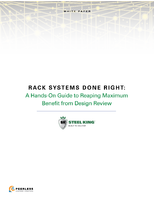Ball Screws feature elastic spacer technology.
Press Release Summary:
 Ball Screws use elastic spacers to separate recirculating balls inside nut, allowing them to achieve extremely fine and slow motion consistently. When nut is fully assembled, slight compression of each elastic spacer between 2 adjacent balls ensures sustained close guidance during recirculation inside nut. Hole in middle of spacer allows adjacent balls to touch in event of jamming, preventing cracking of spacers due to overload.
Ball Screws use elastic spacers to separate recirculating balls inside nut, allowing them to achieve extremely fine and slow motion consistently. When nut is fully assembled, slight compression of each elastic spacer between 2 adjacent balls ensures sustained close guidance during recirculation inside nut. Hole in middle of spacer allows adjacent balls to touch in event of jamming, preventing cracking of spacers due to overload.Original Press Release:
Steinmeyer Announces Ball Screws with Elastic Spacer Technology
Bedford, MA, March 25, 2004 -- Steinmeyer, Inc. announced today an important advance in ball screw technology - the use of elastic spacers to separate recirculating balls inside the nut.
The primary benefit of ball nuts with elastic spacers is the ability to achieve extremely fine and slow motion consistently, for example moving a distance of one micron per second. Intermittent, short strokes, or frequent oscillations are conditions where balls in regular ball nuts tend to back up to each other, significantly increasing inter-ball friction and idling torque, potentially causing instability in the servo loop control. This is eliminated with Steinmeyer elastic spacers. Although offered now in some linear guideways, spacers have not been readily available in ball screws due to reliability concerns.
A flexible ball chain, which works quite reliably in a linear guideway, is more susceptible to failure in a ball nut because of the higher speeds it must sustain and the complex geometry of the ball path it must accommodate. Therefore, instead of a ball chain, Steinmeyer developed and patented a compliant spacer manufactured from durable plastic that resembles two Belleville springs back-to-back.
When the nut is fully assembled, slight compression of each elastic spacer between two adjacent balls ensures sustained close guidance during recirculation inside the nut. One key feature of the new elastic spacer design is the hole in the middle. In the unlikely event of jamming which causes excess force on the balls, the adjacent balls can actually touch each
other (through the spacer hole). Thus compression of the spacers is limited and they are prevented from cracking due to overload. This makes Steinmeyer elastic spacers more reliable
than other plastic spacers. As an added benefit, the elastic spacer does not reduce the number of load balls compared to ball nuts without spacers. This is because the distance between
adjacent balls with Steinmeyer elastic spacers is less than the gap needed in spacer-less ball nuts. And, since Steinmeyer spacers are designed to store lubricant, they have the capability to extend ball screw life in low or even zero maintenance conditions.
Applications for Steinmeyer ball screws with elastic spacers include precision machine tools such as grinding machines, electro-discharge machines (EDMs), and mold making machines.
For further information on ball nuts with elastic spacers from Steinmeyer call 1-800-297-6403 or visit www.steinmeyer.com.




